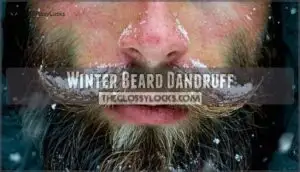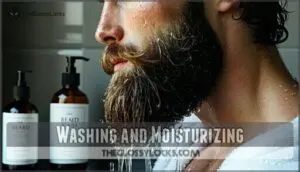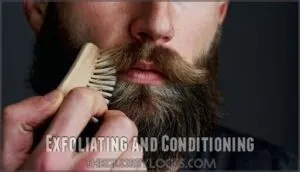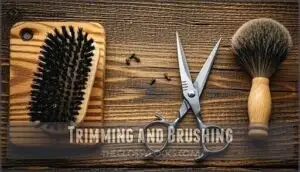This site is supported by our readers. We may earn a commission, at no cost to you, if you purchase through links.

Combat dry skin with a specialized beard wash containing zinc pyrithione or ketoconazole 2-3 times weekly—not daily, as overwashing strips natural oils.
Apply beard oil with jojoba or argan immediately after showering to lock in moisture.
Use a wooden comb to distribute oils and exfoliate dead skin.
Humidify your living space to counteract dry indoor heating.
For stubborn cases, try a tea tree oil solution (5 drops per tablespoon of carrier oil).
Effective beard dandruff control during winter isn’t just about treatment—it’s about creating a microclimate where your facial skin can thrive.
Table Of Contents
- Key Takeaways
- Winter Beard Dandruff
- Managing Dandruff Symptoms
- Beard Care for Dandruff
- Effective Treatment Options
- Preventing Dandruff Recurrence
- Frequently Asked Questions (FAQs)
- How do I stop dandruff on my beard?
- Why is my dandruff so bad in the winter?
- How often should I wash my beard if I have dandruff?
- How do I get rid of dead skin under my beard?
- Can diet affect winter beard dandruff?
- How do indoor heaters impact beard health?
- Should beard length change during winter?
- Are humidifiers effective for beard dandruff?
- Can medications worsen winter beard flaking?
- Conclusion
Key Takeaways
- You’ll need to wash your beard only 2-3 times weekly with specialized products containing zinc pyrithione or ketoconazole, as overwashing strips essential natural oils and worsens dandruff.
- You should apply beard oil with jojoba or argan immediately after showering to lock in moisture and prevent the dry skin conditions that lead to winter beard dandruff.
- You can combat environmental factors by using a humidifier in your living space to counteract the moisture-stripping effects of indoor heating and winter’s dry air.
- You’ll benefit from regular exfoliation using a wooden comb or boar bristle brush to distribute oils evenly and remove dead skin cells that contribute to flaking.
Winter Beard Dandruff
Winter’s cold air can strip your skin of moisture, leaving your beard prone to dryness and flakes.
Without proper care, the combination of dry skin and harsh weather can turn your well-groomed beard into a flaky mess.
Causes of Winter Dandruff
Cold weather and dry air are prime culprits of winter beard dandruff.
They suck moisture from your skin, leaving it flaky and irritated. Harsh cleansers strip natural oils, worsening dry beard skin.
Plus, fungal growth thrives when warm, covered skin meets winter. Add in increased skin turnover, and you’ve got the perfect recipe for winter beard dandruff causes, which involves fungal growth.
Effects of Cold Weather
When temperatures drop, cold air affects your skin by stripping away moisture, leading to winter dryness.
The environmental impact of freezing conditions leaves your beard more prone to flakes and irritation.
Combine this with indoor heating’s drying effects, and you’ve got a climate problem for skin health.
Prioritizing seasonal skincare can help manage these beard dandruff causes effectively.
Dry Skin and Dandruff
Dry skin under your beard worsens in winter, often triggering dandruff. With lower sebum production and environmental factors like cold air, skin dryness skyrockets.
Here’s the blockquote based on the paragraph about dry skin and winter beard dandruff:
Winter air steals moisture, turning your beard’s foundation into a flaky battleground where dandruff thrives.
Harsh cleansers can strip oils and exacerbate the problem. Combat dryness and flakes with these steps:
- Use gentle, moisturizing cleansers.
- Apply beard oil daily to lock in moisture.
- Avoid overwashing your facial hair.
- Exfoliate weekly to reduce buildup and promote healthy skin, ultimately helping to prevent dryness.
Managing Dandruff Symptoms
You can tackle beard dandruff by first recognizing common signs like itching, flaking, and greasy patches.
Addressing these symptoms early with proper care guarantees your beard stays healthy and flake-free all winter long.
Identifying Red Flags
Pay attention to persistent itching, red skin, or beard flakes that worsen despite winter beard care.
If ineffective treatments lead to sleep loss or signs of underlying conditions, it’s time to dig deeper.
A dermatologist can help diagnose winter beard dandruff or related issues.
Don’t ignore symptoms—your beard deserves the same attention you’d give a moody car engine in winter.
Dandruff, unlike a dry scalp, is often caused by Malassezia yeast overgrowth, which can lead to more serious skin issues if not properly addressed.
Itching and Flaking
Feeling that relentless winter beard itch? Don’t scratch—it only makes things worse!
For itch relief and flake prevention, gently cleanse your beard with a hydrating wash and exfoliate weekly to clear dead skin.
Skin irritation from dryness amplifies dandruff severity, so moisturizing is key.
Use soothing techniques like applying aloe vera or beard oil to calm skin flakes and keep your beard happy.
Greasy Patches and Scales
Greasy patches and scales often signal beard dandruff caused by excess sebum buildup and Malassezia growth.
The fungus thrives in oily areas, breaking down sebum into oleic acid, which irritates skin.
Accelerated skin cell turnover adds to the scales, and seborrheic dermatitis may worsen, leaving your beard flaky and irritated.
Regular care reduces greasy skin while targeting Malassezia yeast for healthier skin underneath.
Beard Care for Dandruff
Taking care of your beard is essential to keeping dandruff in check, especially during winter when dry skin becomes a bigger problem.
By sticking to a simple routine of washing, exfoliating, and moisturizing, you can prevent flakes and keep your beard looking its best.
Washing and Moisturizing
When managing beard dandruff, proper washing and moisturizing matter. Use a beard wash designed for winter to avoid stripping oils. Follow up with a moisturizer containing hydrating ingredients like aloe vera or jojoba oil.
To keep your beard healthy: Malassezia yeast overgrowth can exacerbate beard dandruff, so using the right shampoo is key.
- Wash 2–3 times per week.
- Apply products evenly for full coverage.
- Dry gently without rubbing aggressively.
Exfoliating and Conditioning
Exfoliating your beard twice a week removes flakes, while conditioning restores hydration during winter.
Use a gentle DIY scrub or boar’s hair brush for effective exfoliation. Follow with a beard conditioner containing hydrating agents for softness and beard moisturizing.
A quality beard scrub can further enhance exfoliation.
For detailed care:
| Product Type | Examples | Benefit | Frequency |
|---|---|---|---|
| DIY Scrubs | Sugar & oil mix | Removes dead skin | Twice weekly |
| Brush Types | Boar’s hair brush | Exfoliates skin effectively | Daily |
| Conditioning Agents | Argan oil, shea butter | Restores hydration in winter | Daily |
| Oil Application | Light beard oils | Adds soothing moisture | Post-wash |
Trimming and Brushing
Although trimming seems simple, keeping your beard styled and healthy requires thought.
A well-trimmed beard isn’t just about looks—it’s essential for skin health beneath those magnificent whiskers.
Use these tips for beard grooming:
- Proper Trimming: Use sharp trimmers to prevent tugging.
- Brushing Technique: Brush daily to exfoliate and distribute oils.
- Tool Selection: Boar bristle brushes work best.
- Style Maintenance: Trim edges for neatness.
- Growth Impact: Regular trimming minimizes split ends and reduces dandruff.
Effective Treatment Options
In the case of treating beard dandruff during winter, you’ve got plenty of effective options.
From medicated shampoos to natural remedies and nourishing beard oils, these solutions help keep flakes under control while soothing your skin, which is a complete concept for managing the issue.
Medicated Shampoos
Tackling beard dandruff starts with medicated shampoos like those with ketoconazole, selenium sulfide, or pyrithione zinc.
These antifungal options target the root cause—Malassezia fungus—while reducing flakes and irritation.
Massage the shampoo into your beard for effective application, following usage frequency recommendations.
Explore options for ketoconazole beard shampoo for targeted relief.
Keep it consistent, and you’ll find the strength to manage even stubborn winter beard dandruff effectively.
Natural Remedies
Skip the harsh shampoos and explore natural remedies for beard dandruff this winter.
Aloe Vera soothes itchiness, while Lemon Juice exfoliates gently. Tea Tree fights fungi, Coconut Oil locks in moisture, and Baking Soda tackles flaky patches.
These simple beard care tips can keep your beard dandruff-free, even in frigid weather—because a flaky beard isn’t on anyone’s wishlist.
Consider also that aloe vera hydrates and strengthens the skin barrier with the help of Coconut Oil.
Beard Oils and Creams
If natural remedies leave you wanting more, consider beard products formulated for winter.
Beard oils with nourishing ingredients like jojoba and argan prevent dryness and flaking, while balms seal in moisture.
Apply creams evenly after washing for soft, healthy skin.
Prioritize quality when choosing products, or try DIY recipes for budget-friendly care.
Consider using a quality beard dandruff treatment for ideal results.
Consistent use boosts your beard’s health!
Preventing Dandruff Recurrence
You’ll need to maintain a consistent skincare routine to keep beard dandruff from making an unwelcome comeback, especially during the harsh winter months.
Regular washing with appropriate beard products, coupled with seasonal adjustments to your care regimen, will prevent those frustrating flakes from turning your dark sweaters into winter wonderlands.
Consistent Skincare Routine
Now that you’ve got the right treatments, consistency is your best ally.
A daily beard care routine keeps dandruff at bay. Start with gentle cleansing each morning, followed by regular moisturizing with beard oil.
Add gentle exfoliation 2-3 times weekly to remove dead skin. Product application should follow the same sequence daily.
Stick with it—even when flakes aren’t visible—to maintain skin hydration and prevent beard dandruff from returning.
Seasonal Adjustments
While maintaining your daily routine is key, your beard faces different challenges as seasons change.
In winter, you’ll need to adapt your routine to combat the harsh effects of cold air and indoor heating.
Switch to richer beard oils and balms during colder months to lock in moisture. Consider using humidifiers indoors to counter dry air.
Low humidity can cause winter hair issues, exacerbating beard dandruff. Even with product changes, consistent care remains your beard’s best defense against winter dandruff.
Healthy Lifestyle Habits
Your daily habits can substantially impact your beard’s health and dandruff control.
Beyond proper beard hygiene, these lifestyle factors help prevent flakes:
- Stay hydrated – drinking enough water maintains skin moisture beneath your beard
- Prioritize adequate sleep for cell regeneration and repair
- Consume nutrient-dense foods rich in vitamins A, E, and biotin
- Incorporate stress reduction techniques since stress can trigger dandruff flare-ups to maintain overall wellness
Frequently Asked Questions (FAQs)
How do I stop dandruff on my beard?
Your beard is crying out for mercy!
Wash with anti-fungal shampoo containing ketoconazole or pyrithione zinc.
Exfoliate gently 2-3 times weekly, moisturize with beard oil, and maintain consistent hygiene to control dandruff effectively with ketoconazole.
Why is my dandruff so bad in the winter?
Winter’s dry air strips moisture from your skin, causing flaking under your beard.
Indoor heating worsens this effect.
Your skin’s natural oil production slows in cold weather, leaving your beard area more prone to dandruff.
How often should I wash my beard if I have dandruff?
Like a champion fighter, you’ll need to wash your beard 2-3 times weekly with a gentle cleanser.
On non-wash days, use beard oil to maintain moisture and prevent those pesky winter flakes.
How do I get rid of dead skin under my beard?
Exfoliate gently with a soft beard brush, use a specialized scrub twice weekly, and apply beard oil to moisturize.
Wash with beard-specific cleansers that won’t strip natural oils from your face.
Can diet affect winter beard dandruff?
While skeptics may doubt it, your diet directly impacts beard dandruff during winter.
Increasing omega-3 fatty acids, zinc, and vitamin E can reduce inflammation and flaking by supporting skin hydration from within your body, which can help reduce inflammation.
How do indoor heaters impact beard health?
Indoor heaters dry out your skin and beard, causing flakiness and itching.
They strip moisture from hair follicles, creating perfect conditions for dandruff.
Counter this by using humidifiers and applying beard oil regularly.
Should beard length change during winter?
As winter winds howl, keeping your beard slightly longer provides natural insulation and protection against harsh conditions.
You’ll reduce skin dryness and dandruff while maintaining warmth, but don’t forget to adjust your maintenance routine accordingly to ensure your beard remains healthy.
Are humidifiers effective for beard dandruff?
Yes, humidifiers are effective for beard dandruff by adding moisture to the air that hydrates your skin.
They’ll help prevent the dry, flaky skin under your beard that worsens during winter months.
Can medications worsen winter beard flaking?
Certain medications like isotretinoin or lithium can indeed worsen your beard flaking during winter by increasing skin dryness.
Blood pressure medications may also contribute to flaking by altering your skin’s natural oil production, which can be a significant factor in skin dryness.
Conclusion
Contrary to popular belief, beard dandruff control during winter doesn’t require expensive products.
By establishing a consistent routine of gentle washing, regular moisturizing, and proper exfoliation, you’ll create the ideal environment for healthy facial skin.
Remember, your beard deserves specialized care when temperatures drop.
Don’t let flakes dampen your winter style—implement these practical strategies, adjust as needed, and you’ll maintain a flake-free, comfortable beard throughout the coldest months.
Your skin (and anyone who gets close) will thank you.












